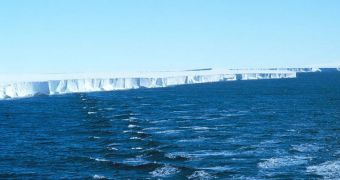The conclusions of a new scientific research bring about new concerns that two of the largest ice masses on the planet – Greenland and the Antarctic – are melting away at much faster rates than previously calculated.
There are significant implications to this discovery, experts say, especially in terms of what its effects will be on the world. These are two of the three vastest ice expanses in the world, alongside the Arctic.
In order to arrive at this conclusion, the research team analyzed data related to ice loss spanning more than 20 years. Scientists determined that ice loss from the two regions is now the primary driver of sea level rise across the world's oceans.
The phenomenon even surpassed that of ice loss from mountain glaciers and ice caps. This was predicted in climate models, but was not expected to take place so soon, LiveScience reports.
Experts compared ice loss rates for the past two decades, but especially in 2006. That year, another research team conducted a measurement of ice loss from glaciers and ice caps, and so the scientists had a reference frame to compare the two.
“That ice sheets will dominate future sea level rise is not surprising – they hold a lot more ice mass than mountain glaciers,” explains expert Eric Rignot, the lead author of the new investigation.
What is surprising is this increased contribution by the ice sheets is already happening,” adds the researcher, who holds joint appointment at the NASA Jet Propulsion Laboratory (JPL), in Pasadena, and at the University of California in Irvine (UCI).
Details of the research appear in this month's issue of the journal Geophysical Research Letters.
For the purpose of the research, ice sheets were defined as being ice accumulations larger than 20,000 square miles (50 square kilometers). Such large amounts of ice are only found in Greenland and the Antarctic. Ice caps were defined as having a surface smaller than this threshold level.
On average, the two ice sheets lost 475 billion metric tons (gigatons) of ice yearly. As a result, global sea levels rose by 1.3 millimeters annually. In the 2006 comparison, mountain glaciers and ice caps lost 402 gigatons of ice.
The worrying news is that the ice sheets appear to be losing mass at an ever-accelerating rate, as the effects of global warming and climate change create feedback effects forcing more ice to melt.
“If present trends continue, sea level is likely to be significantly higher than levels projected by the United Nations Intergovernmental Panel on Climate Change in 2007,” Rignot reveals.
Over the next 40 years, sea levels could rise by 5.9 inches (15 centimeters) if the trend persists. Add to this 3.1 inches (8 centimeters) from ice caps and 3.5 inches (9 centimeters) from ocean thermal expansion and you get 12.5 inches (32 centimeters) in less than half a decade.

 14 DAY TRIAL //
14 DAY TRIAL //